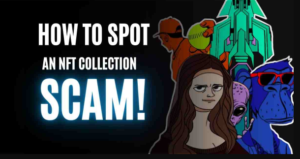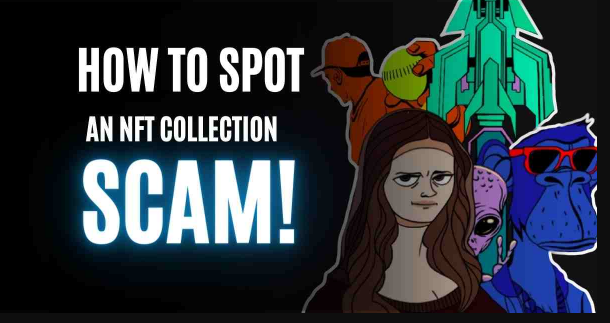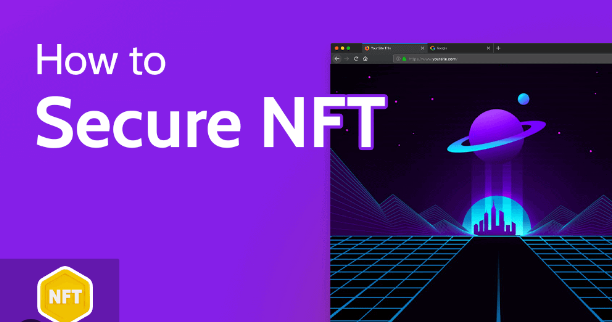
Whether you’re a seasoned NFT collector or just dipping your toes into the metaverse, it’s crucial to do your research before investing in a new NFT project. With the hype around NFTs skyrocketing in 2021, many illegitimate projects have emerged looking to take advantage of the excitement.
Before buying into any NFT launch, take the time to thoroughly evaluate the project across a number of factors. Here are 30 signs to help determine if an NFT collection is legitimate or a potential scam.
Key Takeaways
- Brand recognition, community size, and identity of the creator are the most important factors to consider when evaluating the validity of an NFT project.
- Conduct extensive research before investing in NFT projects.
- Use a hardware wallet, software wallet, or IPFS to store your NFTs securely.
- Best practices for securing your NFT assets include using a robust VPN and an antivirus.
Background on NFTs
An NFT (non-fungible token) is a unique digital asset recorded on a blockchain. NFTs represent ownership of unique items like art, collectibles, and even real estate.
Unlike cryptocurrencies, NFTs are not interchangeable. Each one has distinguishing information making it one-of-a-kind. This also makes NFTs illiquid compared to crypto coins and tokens.
The NFT market exploded in 2021, with sales volume surging to $25 billion. NFT mania has continued into 2022, though at a slower pace.
As NFTs gain popularity, many projects launch aiming to capitalize on the hype. Some of these projects are speculative, rushed or even outright scams. This makes it critical to assess legitimacy before investing time or money into any new NFT collection.
Real Founders with Credentials
A core team with credentials adds legitimacy to any NFT project. Look for information on the founders and their professional backgrounds. Do they have experience building successful blockchain projects before?
For established founders, you may find links to their LinkedIn, Twitter, or personal websites. unknown project leads without an online presence are a red flag.
Clear Business Model and Utility
A quality NFT project should clearly explain the utility of its NFTs and long-term business model. Beware of projects taking advantage of hype without a solid plan for delivering real value to holders.
Ask yourself:
- Why would these NFTs retain or increase in value over time?
- What benefits do they provide to holders?
- How does the project plan to develop over months and years?
Lack of clear answers indicates you’re dealing with a low-quality or scam project.
Community Engagement
Look at the project’s social media channels and community spaces. Is there an active, organic community of early supporters? This indicates strong engagement and interest in the NFT collection.
Too little activity or community could mean the project won’t gain enough momentum. Meanwhile, fake engagement from bots or paid shills is also a major red flag.
Transparent Roadmap
Reputable projects are upfront with holders about their roadmap and future plans. Look for a detailed, multi-phase roadmap shared publicly with the community.
Watch out for projects with vague or non-existent roadmaps. It may signify they lack long-term vision and goals.
Professional Website and Branding
A scam project often has a low-quality website and branding. Look out for:
- Typos, grammatical errors
- Sloppy designs
- Generic content
- Copycat branding mimicking other major NFTs
Meanwhile, professional projects invest in their online presence with unique, high-quality designs, content and branding. This demonstrates their overall legitimacy.
Public Team Members
Anonymous founders are a big risk when investing in NFTs. Pseudonyms are common, but quality projects still have information on core team members.
Look for details like:
- Full names
- Photos
- Links to social media profiles
- Previous projects and experience
Public team members add accountability and credibility to projects.
Previous Projects or Experience
Have the founders delivered successful NFT or crypto projects before? Past experience gives investors confidence in the abilities of the current team.
For newer founders, look at their previous professional experience. Relevant backgrounds in art, crypto/blockchain, design, marketing, and business development are good signs.
Public Minting and Launch Process
Legitimate NFT creators are transparent about minting and launch plans. They provide details like:
- Mint dates
- Number of NFTs available
- Mint price per NFT
- Marketplaces where they’ll be listed
Shady projects offer little info about the minting and launch. Blind mints requiring payment upfront are especially risky.
Reasonable Mint Price
High-quality NFT projects price their mints fairly based on the value, utility, and benefits provided to holders.
Be wary of projects with mint prices significantly below market rate to generate hype. It may just be a scam to drive volume before creators disappear with buyer funds.
Audit Reports from Known Firms
Audits by reputable blockchain security firms help ensure the project’s smart contracts are safe and functional. Projects seriously focused on quality get their code audited before launch.
Lack of auditing creates major risks for buyers and destroys trust in project developers.
More Factors Demonstrating Legitimacy
So those are 10 initial factors providing insight into the legitimacy of an NFT project. Here are 20 more signs to evaluate during your research process.
Legal Compliance
Professional projects comply with relevant laws and regulations in their jurisdiction. They incorporate properly and obtain licenses if required.
Meanwhile, scams often blatantly ignore legal requirements which exposes buyers to major risks.
Non-Fungible Tokens
Despite the name, some NFT projects issue fungible tokens or coins alongside their NFTs. These may still derive value from the broader ecosystem and community.
However, most high-quality NFT projects focus on the non-fungible NFTs which can’t be replicated. Unique token IDs and metadata make them provably scarce digital assets.
Locked Liquidity Pool
Reputable projects lock a percentage of their treasury liquidity to help prevent “rug pull” scams. This ensures project creators can’t immediately drain the liquidity pool and disappear with investors’ funds.
No liquidity locking means founders could pull all capital out at any time and instantly make the project worthless.
Reasonable Supply Cap
NFT projects should have reasonable caps on total supply. This prevents hyperinflation which could severely decrease NFT values.
Insufficient supply caps, or even unlimited supply, enable “mint-and-dump” schemes where founders endlessly dilute NFT value to profit themselves.
Clear Metadata Standards
Thoughtful metadata improves the functionality and trading of NFTs on marketplaces. Quality standards include attributes like:
- Title
- Description
- Artist/Creator
- Date Created
- External Link
Missing or unclear metadata standards create headaches for buyers trying to evaluate or list their NFTs.
Thoughtful Tokenomics Model
The tokenomics model outlines how founders, developers, and the community share in the project’s financial upside. Look for models aligning incentives properly without enabling exploitation.
For example, founders allocating 50% or more of tokens to themselves is a risky sign of misaligned incentives.
Public Access to Contracts
Smart contract code for legitimate projects is visible and verifiable on the blockchain. This enables technical evaluation by community members.
Lack of transparency around contract code is a major risk. It provides no way to assess what the contracts actually do.
Established Marketplace Listings
Being listed on major NFT marketplaces like OpenSea adds legitimacy to newer projects. However, obscure marketplace listings may be the only option for some projects to launch.
Focus on other factors to determine if a project listing on a less-known marketplace is legitimate or not.
Positive Social Sentiment
Assess community spaces like Discord and Twitter. Is there genuine excitement and engagement about the NFTs from real users?
Too much fake hype or obvious shilling are red flags. But natural enthusiasm indicates an attractive project.
Major Partnerships and Investors
Backing from crypto VC funds or partnerships with major brands brings expertise and oversight to projects. This adds an extra layer of protection against potential scams.
A lack of external validation doesn’t automatically make a project illegitimate. But major support does enhance legitimacy.
Protection for IP Rights
Professional projects secure proper licenses and rights to any intellectual property used in their NFTs. This includes art, branding, collectibles, patents, and more.
Unauthorized IP usage is unethical, signifies amateurism, and exposes the project to legal trouble.
Responsiveness to Community
Consider how founders interact with potential buyers in community channels. Do they engage positively and address key questions?
Ignoring community concerns often exposes a lack of commitment to buyers. Engagement builds trust.
Willingness to Address Issues
Project developers should directly acknowledge and address issues raised by community members. Every project will likely face criticisms and problems at some point. Responsibly handling them is key.
Scams tend to deflect blame or ignore concerns entirely. Legitimate teams address issues with transparency.
Moderate Promotional Claims
It’s common for founders to talk up their projects and highlight potential upsides. But beware of projects making extreme, exaggerated claims to generate hype.
Legitimate teams make factual, realistic claims about their NFTs. Outlandish promises often signify shallow scam projects.
Established Project Roadmap
Scams tend to launch without much planning or long-term vision. Reputable projects have detailed roadmaps covering months and years. This requires thoughtful vision and execution planning.
The lack of an established roadmap indicates founders may neglect long-term development.
Team Commitment to Roadmap
It’s one thing to create an impressive roadmap. It’s another to actually follow it. Assess if the team regularly hits major milestones laid out in their roadmap.
Failure to execute on roadmap promises is a major red flag. It may signify poor planning, lack of resources or even intent to scam.
Third-Party Security Audits
Audits by respected blockchain security firms help ensure the technical soundness and safety of smart contracts. This protects buyers against code flaws that scammers can exploit.
Neglecting thorough auditing creates security risks for participants.
Legal Entity with Registered Business
Legitimate projects are incorporated as legal business entities in their jurisdictions. This brings regulatory oversight and accountability.
Anonymous founders and entities allow scammers to disappear without a trace. Don’t provide money to unregistered groups.
Customer Service Availability
Professional projects provide customer service via social media, emails or chat to address issues raised by community members and buyers. This provides support channels when problems inevitably occur.
Inaccessible projects leave you helpless if something goes wrong. Make sure viable support options are available.
Whitepaper Explaining Technology Use
A technical whitepaper demonstrates the legitimacy of the project’s blockchain architecture and applications. Lack of technical details exposes gaps in planning and development.
Well-documented technology decisions increase trust in the capabilities of the team.
Conclusion
Thoroughly researching and evaluating NFT projects across these factors takes time. But it’s a mandatory step before investing in any new collection.
Focus on signs demonstrating long-term vision, commitment, and accountability. Monitor community spaces for organic engagement. Validate credentials and track records of founders.
With diligence, you can filter out scam projects from promising NFTs worth buying and holding. The extra upfront effort provides peace of mind and protection for your investment.

